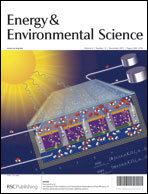Coordinated shifts of interfacial energy levels: insight into electron injection in highly efficient dye-sensitized solar cells
Abstract
Coordinated shifts on the order of ∼100 meV were found in the interfacial energy levels of ruthenium dye molecules and the conduction band of nano-crystalline TiO2. The shifts were induced by potential-determining additives used in highly efficient dye-sensitized solar cells. The observation of comparable shifts of interfacial energy levels in dye/TiO2 films is beyond the conventional understanding of the varied quantum efficiency of interfacial electron injection, which had been derived under the assumption of the band shift only in TiO2. Based on general physical concepts, we advanced the understanding of the electron injection mechanism and attributed the variable electron injection efficiency to the influence of potential-determining additives on the interfacial electronic structures of both the dyes and TiO2. Our results revealed that the interfacial dipole layer affected the electronic coupling between the donor states in photo-excited dyes and the acceptor states in TiO2, which led to changes in electron injection. The present model also explains the correlation between the radiative recombination, an important loss mechanism in solar cells, of photo-excited states of the anchored dye/TiO2 in operational cells and that of free dye molecules in solution. We also found the amount of coordinated shifts to be most likely related to the number of COOX groups in ruthenium dyes and metal-free organic dyes. This relationship implies that the effect of coordinated shifts in ruthenium dyes/TiO2 is one of the most probable reasons why these dyes enable higher performance than do metal-free organic dyes, in which the latter only have relatively small coordinated shifts. This discovery provides deeper insight into the interfacial electron injection mechanism and points out the importance of the realignment effect on interfacial energy levels in highly efficient dye-sensitized solar cells.


 Please wait while we load your content...
Please wait while we load your content...